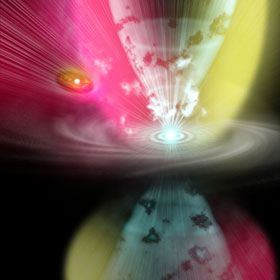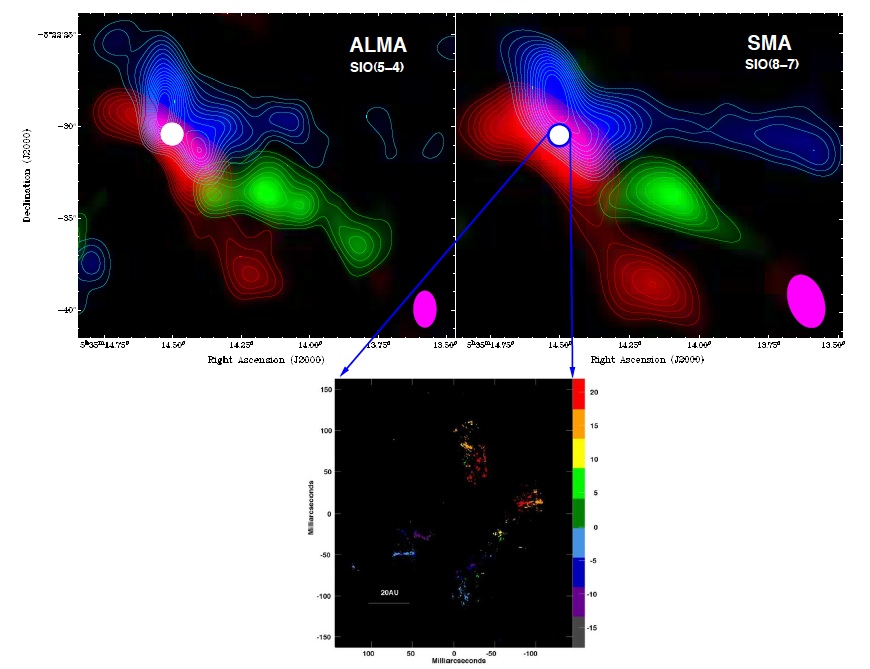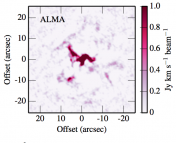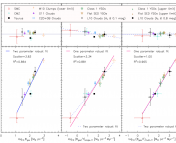Title: ALMA observations of the outflow from the Source I in the Orion-KL region
Authors: Luis A. Zapata, Luis F. Rodríguez, Johannes Schmid-Burgk, Laurent Loinard, Karl M. Menten, and Salvador Curiel
First Author’s Institution: Centro de Radioastronomía y Astrofísica, UNAM, México
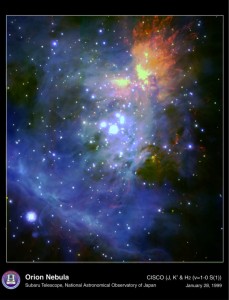
This infrared view of Orion with the Subaru telescope shows the Kleinmann-Low region in orange in the upper right, where a very young star is forming and creating the butterfly-shaped features discussed in today's paper.
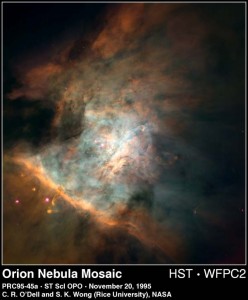
The Hubble Space Telescope view of the Great Nebula in Orion. The nebula forms part of the sword in the constellation of Orion. On a clear, dark night, you can discern some fuzzy detail in the nebula with your naked eyes.
The Orion Nebula has become an iconic example of star formation at its most beautiful. On a clear, dark night you can see the Orion Nebula with your naked eye, situated just south of Orion’s belt and making up part of his sword. With binoculars or a small telescope you start to see some fuzzy yet colorful details of this dusty and gaseous region. When observed with professional telescopes, and by detecting emission at a range of wavelengths, astronomers study the many massive, young stars in this Nebula in order to understand the very early stages of formation. This stellar nursery is a popular target due to its relative proximity to the Earth (only slightly more than 1000 light years, or 400 parsecs) and high number of very young stars, allowing for a detailed study of the star formation process. For more on the star formation process, check out these astrobites about disks, protostellar outflows, and related topics.
In today’s paper, the authors present new observations of one particular region within the Orion Nebula, called Source I of the Kleinmann-Low (KL) nebula. Within the KL nebula is a binary system composed of two young stellar components very close together, with a separation of only a few astronomical units, in other words almost as near to each other as the Earth and the Sun. Adding to the intrigue of this region, an explosive outflow emanates from this region, a result of the active star formation found here and profoundly affecting the surroundings (for further reading, see Bally et al. 2011).
As a brief review of the star formation process, take a look at the figure to the left. Matter falls onto a forming star via an accretion disk (the frisbee-shaped central region in the image), but in the meantime some of the material is ejected in the form of bipolar outflows. Because the components of a star as it forms have different temperatures and velocities, observations at different wavelengths/frequencies reveal the distinct features. The goal is to tell the complete story of how stars form, and what is the effect on the surrounding molecular cloud environment. In today’s paper, Zapata et al. detect emission from the outflowing gas.
The Observations:
The new Atacama Large Millimeter/sub-mm Array (ALMA) observed the KL nebula as a “Science Verification” program, displaying several observing capabilities of the new observatory in its earliest stage of operation. The data were released publicly, so that you too can take a look if you like. Zapata et al. took the opportunity to compare the 2012 ALMA data with observations from the Sub-millimeter Array (SMA) taken in 2009. While the ALMA observations detect SiO emission at 217 GHz, the SMA observations detect a higher-order rotational transition of SiO at 347 GHz (a great summary of molecular transitions can be found in this astrobite). While it can be expected that emission at different frequencies trace slightly different features of the outflows, the authors seek to compare the overall morphology of the outflows. They also show that ALMA, with only a small fraction of the total antenna array constructed at the time of the observations, has surpassed previous observations in terms of sensitivity (the amount of light collected) and angular resolution (the amount of detail discerned) when observing SiO outflow emission.
Results:
The results of the observations can be seen in the figure above. The authors call the shape of the outflow a “butterfly morphology”, symmetric over a northeast-southwest axis, with the blue “wing” in the northwest and the red “wing” in the southeast (note: in these figures, east is to the left, and west is to the right). A comparison of the observations with ALMA, SMA and VLBA (see Matthews et al. 2010 for observations with the Very Long Baseline Array) show several interesting features. First, high-velocity emission (from gas moving at about 30 km/s, or more than 60,000 mph!) is found at the middle of the “wings”, shown in green in the figure, along the same NE-SW axis. Second, the blue wing forms a U-shape, whereas the red-wing only forms part of a U, possibly due to density inhomogeneities in the surrounding region. Finally, when this region was observed with VLBA at high angular resolution, the axis-symmetry seems to be NW-SE, opposite to that seen for emission farther from the central source.
Explanations for the observed morphology:
1. Two separate bipolar outflows emanate from a pair of young stars at the center of a disk. One blue-shifted outflow lobe is moving approximately north, and its counterpart red-shifted lobe is moving approximately south. A second outflow has an east-west axis, with a blue-shifted lobe moving to the west and the red-shifted lobe moving to the east. Further, if the binary is precessing, different velocities might be detected at different distances from the source. The authors find that the problem with this hypothesis is in explaining the high-velocity tail (in the southwest) that is observed in the middle of the outflows.
2. SiO might trace gas that has been ejected in bursts from a small disk associated with the source. However, at larger scales this ejecta from the rotating disk should appear as an expanding structure, rather than rotating, and the observations don’t show this. The authors rule out this option.
3. One bipolar outflow might be expanding from a rotating disk, and it might be wide enough to produce the morphology that is observed (like a cone emanating outwards). Different radial velocities would be observed at different scales if the rotation of the disk had changed over time, perhaps if a lot of matter fell back onto the disk and changed the rotation. The authors note that the idea of enough matter falling back onto the disk in a way that would invert its rotation is rather unusual, and deserves further theoretical and observational studies.

